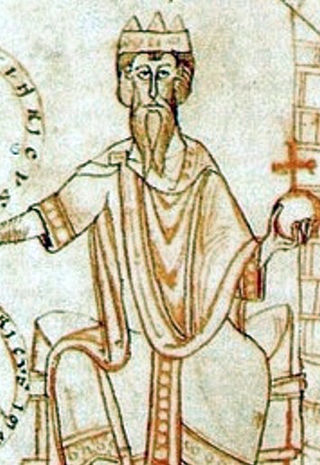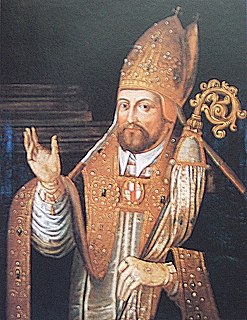Sources
- Zippelius, Reinhold. Kleine deutsche Verfassungsgeschichte, 7th. ed. Munich: 2006 ISBN 978-3-406-47638-9.
The Statutum in favorem principum ("Statute in favour of the princes") of 1231, reaffirmed in 1232, counts as one of the most important sources of law of the Holy Roman Empire on German territory.
In May 1231 Frederick II's son Henry, King of Germany, issued the grant under pressure from the German secular princes during his rebellion against his father. The terms were very similar to those conceded to the ecclesiastical princes or bishops in the Confoederatio cum principibus ecclesiasticis at the time of the Henry's coronation (in 1220), conferring similar rights. Frederick II confirmed the grant in May 1232.
In this law, the Emperor relinquished a number of important Royal rights ("Regalia") to the secular princes. Among other things, they received the rights to mint coins and levy tolls in the German part of the Holy Roman Empire. In particular, however, Frederick granted them the right of approval over any legislation proposed in future by the Emperor.
The decreeing of this law together with the previous Confoederatio made the power and influence of the territorial princes in relation to the Empire and the towns extraordinarily great. Frederick's aim was to leave his Empire north of the Alps secure under the direct rule of the princes, allowing him to concentrate his efforts on the southern part of the Empire. This rule of the land by the princes was nevertheless secured at the expense of the centralised power of the monarchy.

The Holy Roman Empire, also known as the Holy Roman Empire of the German Nation after 1512, was a polity in Central and Western Europe, usually headed by the Holy Roman Emperor. It developed in the Early Middle Ages and lasted for almost a thousand years until its dissolution in 1806 during the Napoleonic Wars.

The Hohenstaufen dynasty, also known as the Staufer, was a noble family of unclear origin that rose to rule the Duchy of Swabia from 1079, and to royal rule in the Holy Roman Empire during the Middle Ages from 1138 until 1254. The dynasty's most prominent rulers – Frederick I (1155), Henry VI (1191) and Frederick II (1220) – ascended the imperial throne and also reigned over Italy and Burgundy. The non-contemporary name of 'Hohenstaufen' is derived from the family's Hohenstaufen Castle on Hohenstaufen mountain at the northern fringes of the Swabian Jura, near the town of Göppingen. Under Hohenstaufen rule, the Holy Roman Empire reached its greatest territorial extent from 1155 to 1268.

Conrad II, also known as Conrad the Elder and Conrad the Salic, was the emperor of the Holy Roman Empire from 1027 until his death in 1039. The first of a succession of four Salian emperors, who reigned for one century until 1125, Conrad ruled the kingdoms of Germany, Italy and Burgundy.

A prince-bishop is a bishop who is also the civil ruler of some secular principality and sovereignty, as opposed to Prince of the Church itself, a title associated with cardinals. Since 1951, the sole extant prince-bishop has been the Bishop of Urgell, Catalonia, who has remained ex officio one of two co-princes of Andorra, along with the French president.

Frederick II was King of Sicily from 1198, King of Germany from 1212, King of Italy and Holy Roman Emperor from 1220 and King of Jerusalem from 1225. He was the son of Emperor Henry VI of the Hohenstaufen dynasty and Queen Constance of Sicily of the Hauteville dynasty.
A count palatine, also count of the palace or palsgrave, was originally an official attached to a royal or imperial palace or household and later a nobleman of a rank above that of an ordinary count. The title originated in the Late Roman Empire. In the Middle Ages especially and into modern times, it is associated with the Holy Roman Empire, especially Electoral Palatinate.

The history of Schleswig-Holstein consists of the corpus of facts since the pre-history times until the modern establishing of the Schleswig-Holstein state.

The Prince-Archbishopric of Bremen — not to be confused with the modern Archdiocese of Hamburg, founded in 1994 — was an ecclesiastical principality (787–1566/1648) of the Holy Roman Empire and the Catholic Church that after its definitive secularization in 1648 became the hereditary Duchy of Bremen. The prince-archbishopric, which was under the secular rule of the archbishop, consisted of about a third of the diocesan territory. The city of Bremen was de facto and de jure not part of the prince-archbishopric. Most of the prince-archbishopric lay rather in the area to the north of the city of Bremen, between the Weser and Elbe rivers. Even more confusingly, parts of the prince-archbishopric belonged in religious respect to the neighbouring Diocese of Verden, making up 10% of its diocesan territory.

The Archbishopric of Magdeburg was a Latin Catholic archdiocese (969–1552) and Prince-Archbishopric (1180–1680) of the Holy Roman Empire centered on the city of Magdeburg on the Elbe River.

Henry (VII) (1211 – 12 February 1242), a member of the Hohenstaufen dynasty, was King of Sicily from 1212 until 1217 and King of Germany (formally Rex Romanorum) from 1220 until 1235, as son and co-ruler of Emperor Frederick II. He was the seventh Henry to rule Germany, but in order to avoid confusion with the Luxembourg emperor Henry VII, he is usually numbered Henry (VII).

The Confoederatio cum principibus ecclesiasticis was decreed on 26 April 1220 by Frederick II as a concession to the German bishops in return for their co-operation in the election of his son Henry as King. It was an important source of law of the Holy Roman Empire, and was counted among its constitutional documents by the editors of the Monumenta Germaniae Historica.

The House of Luxembourg or Luxembourg dynasty was a royal family of the Holy Roman Empire in the Late Middle Ages, whose members between 1308 and 1437 ruled as kings of Germany and Holy Roman emperors as well as kings of Bohemia, Hungary and Croatia. Their rule was twice interrupted by the rival House of Wittelsbach. The family takes its name from its ancestral county of Luxembourg which they continued to hold.

Prince of the Holy Roman Empire was a title attributed to a hereditary ruler, nobleman or prelate recognised by the Holy Roman Emperor.

The Duchy of Austria was a medieval principality of the Holy Roman Empire, established in 1156 by the Privilegium Minus, when the Margraviate of Austria (Ostarrîchi) was detached from Bavaria and elevated to a duchy in its own right. After the ruling dukes of the House of Babenberg became extinct in male line, there was as much as three decades of rivalry on inheritance and rulership, until the German king Rudolf I took over the dominion as the first monarch of the Habsburg dynasty in 1276. Thereafter, Austria became the patrimony and ancestral homeland of the dynasty and the nucleus of the Habsburg monarchy. In 1453, the archducal title of the Austrian rulers, invented by Duke Rudolf IV in the forged Privilegium Maius of 1359, was officially acknowledged by the Habsburg emperor Frederick III.
Erbreichsplan is a German word meaning "plan for a hereditary empire". It refers to the proposal of Henry VI, Holy Roman Emperor (1191–1197), to abolish imperial election and make the Holy Roman Empire hereditary within his family, the Staufer. This would effectively have combined the Empire and its three kingdoms—Germany, Italy and Burgundy—with the hereditary kingdom of Sicily, which belonged to Henry and his heirs in right of his wife, the heiress Constance. Since Sicily was a papal fief, this plan was strongly opposed by the Papacy. It also failed to generate sufficient support among the imperial princes.

Henry VI, a member of the Hohenstaufen dynasty, was King of Germany from 1169 and Holy Roman Emperor from 1191 until his death. From 1194 he was also King of Sicily.

The Imperial Diet was the deliberative body of the Holy Roman Empire. It was not a legislative body in the contemporary sense; its members envisioned it more like a central forum where it was more important to negotiate than to decide.
In the Holy Roman Empire, the Great Interregnum was a period of time, from 1246 until 1273, following the throne dispute of Frederick II where the succession of the Holy Roman Empire was contested and fought over between pro- and anti-Hohenstaufen factions. Starting around 1250 with the death of Frederick II, the conflict over who was the rightful emperor and King of the Romans would continue into the 1300s until Charles IV of Luxembourg was elected emperor and secured succession for his son Wenceslaus. This period saw a multitude of emperors and kings be elected or propped up by rival factions and princes, with many kings and emperors having short reigns or reigns that became heavily contested by rival claimants.
From the time of Constantine I's conversion to Christianity in the 4th century, the question of the relationship between temporal and spiritual power was constant, causing a clash between the Church and the Empire. The disappearance of imperial power initially enabled the pope to assert his independence. However, from 962 onwards, the Holy Roman Emperor took control of the papal election and appointed the bishops of the Empire himself, affirming the pre-eminence of his power over that of the Church. However, such was the stranglehold of the laity on the clergy that the Church eventually reacted. The Gregorian reform began in the mid-11th century. In 1059, Pope Nicholas II assigned the election of the pope to the college of cardinals. Then, in 1075, Gregory VII affirmed in the dictatus papae, stating that he alone possessed universal power, superior to that of the rulers, and withdrew the appointment of bishops from them. This marked the start of a conflict between the Papacy and the Emperor, which historians have dubbed the "Investiture Dispute". The most famous episode was Henry IV's excommunication and his penance at Canossa to obtain papal pardon. At the end of this conflict, the Pope succeeded in freeing himself from imperial guardianship. In 1122, under the Concordat of Worms, the Emperor agreed to the free election of bishops, reserving the right to give prelates temporal investiture. This compromise marked the defeat of the Empire.